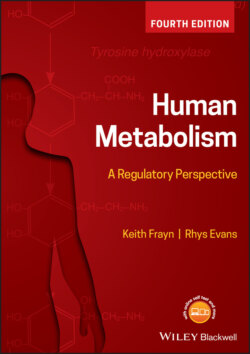Читать книгу Human Metabolism - Keith N. Frayn - Страница 9
Preface
ОглавлениеThe first edition of Metabolic Regulation: A Human Perspective appeared in 1996. (It was pink.) When the second edition was published (in green) in 2003, it seemed that a revolution was taking place in metabolism. Tissues that we always thought were ‘doing metabolism’ turned out to be secreting hormones, adipose tissue and leptin being the prime example. By 2010, when the third (blue) edition was published, there were yet more changes in our understanding of metabolism and its regulation. The regulation of gene expression by nutrients (including, for instance, the carbohydrate-response element binding protein) was much better understood than previously. The techniques of genetic manipulation had also increased our understanding of metabolic pathways. In 1996, nobody could have guessed that a mouse without the adipose tissue enzyme hormone-sensitive lipase would be viable, let alone relatively normal: that finding led to the discovery of another enzyme of fat mobilisation, adipose triglyceride lipase. Similar studies made us revise our ideas about other ‘well-established’ enzymes such as phosphoenolpyruvate carboxykinase. Now, in 2018, we see more radical developments in the field. We always thought that hormones were hormones and metabolites were metabolites – now we know that the distinction is far from clear, with many compounds we regard as metabolites signalling through receptors as do ‘true hormones,’ thereby modulating metabolism. (We note in passing that the late Derek Williamson – colleague to both of us, and mentor to one [RDE], would not have been surprised: he had long predicted that the ketone bodies had a signalling role.)
We have always recognised that this textbook needed to be regarded as a complement to a more conventional biochemistry textbook, which would give details of pathways rather than just notes on their regulation. We have both taught metabolism to biochemistry and medical students in Oxford, and for this edition decided to combine our areas of expertise and to add material to the book that would enable it to be used more independently. Thus, in Chapter 1 of this new edition, we have provided overviews of metabolic pathways that will then be described in more detail in subsequent chapters. A particular emphasis of the later chapters, as in previous editions, is the tissue-specificity of these metabolic pathways. We are aware that this textbook is used by medical and nursing students and that has prompted us to include more material relevant to metabolism in clinical situations such as cancer, sepsis, and trauma. We hope this material will be of interest to all students, including those of nutrition and sports science, as it illustrates how metabolism may be perturbed. The small revision to the title of the book reflects these changes.
We thank Michael Goran, Fredrik Karpe, Denise Robertson and Garry Tan, who have helped us by reading, and commenting on, sections of the book. Any errors remaining are our responsibility. We are enormously grateful to Anne Clark, Mike Symonds and Roy Taylor for providing pictures and data. We give special thanks to Professor Rui Fontes of the University of Porto who translated edition 3 into Portuguese, and in so doing pointed out many errors, most of which had persisted through all the editions. Jenny Seward and James Watson, and their editorial team at Wiley, have been very helpful to us as we prepared this edition. Finally, we thank Theresa and Helen for putting up with us during the hours we spent at the computer producing this new edition.
